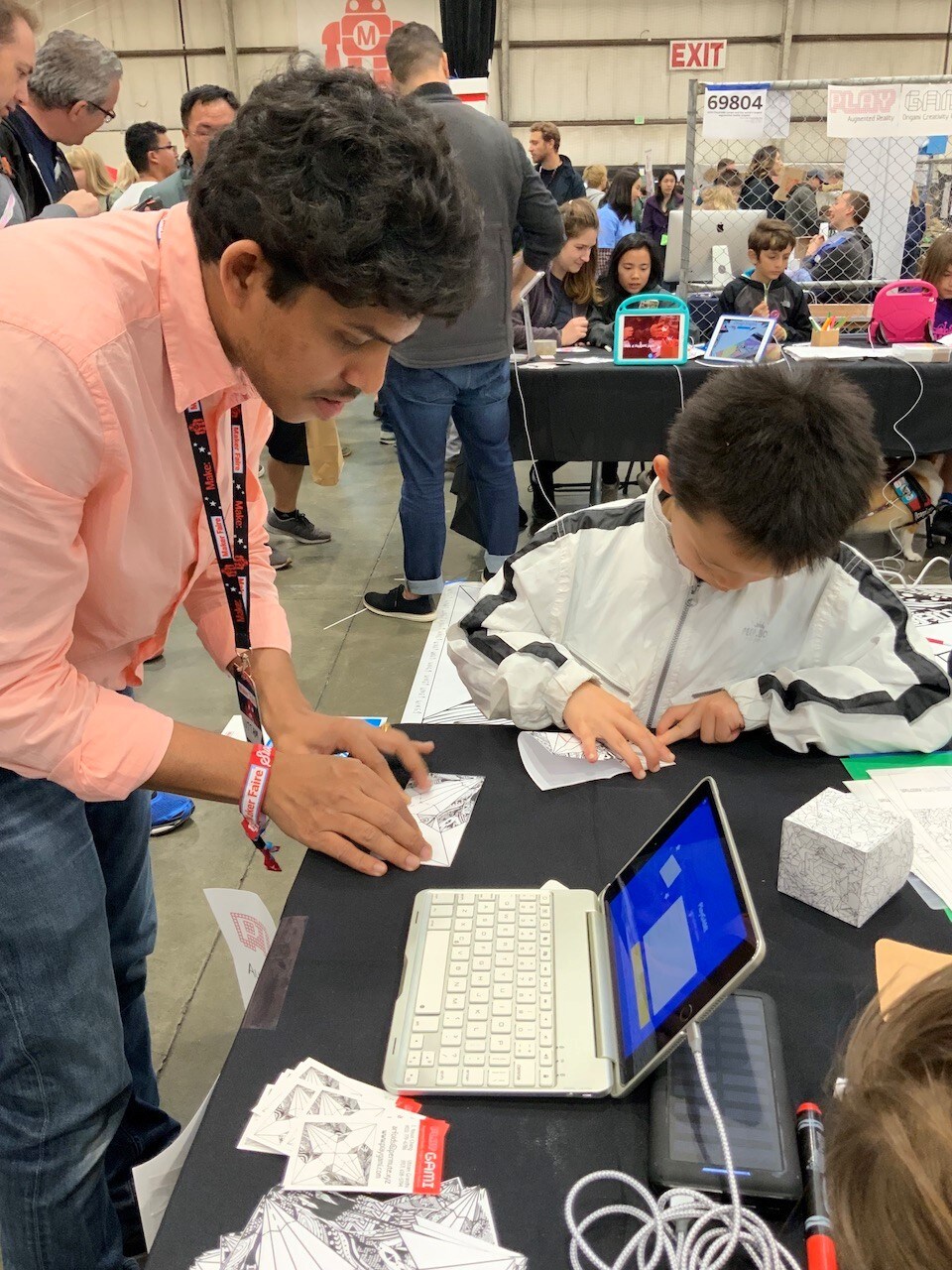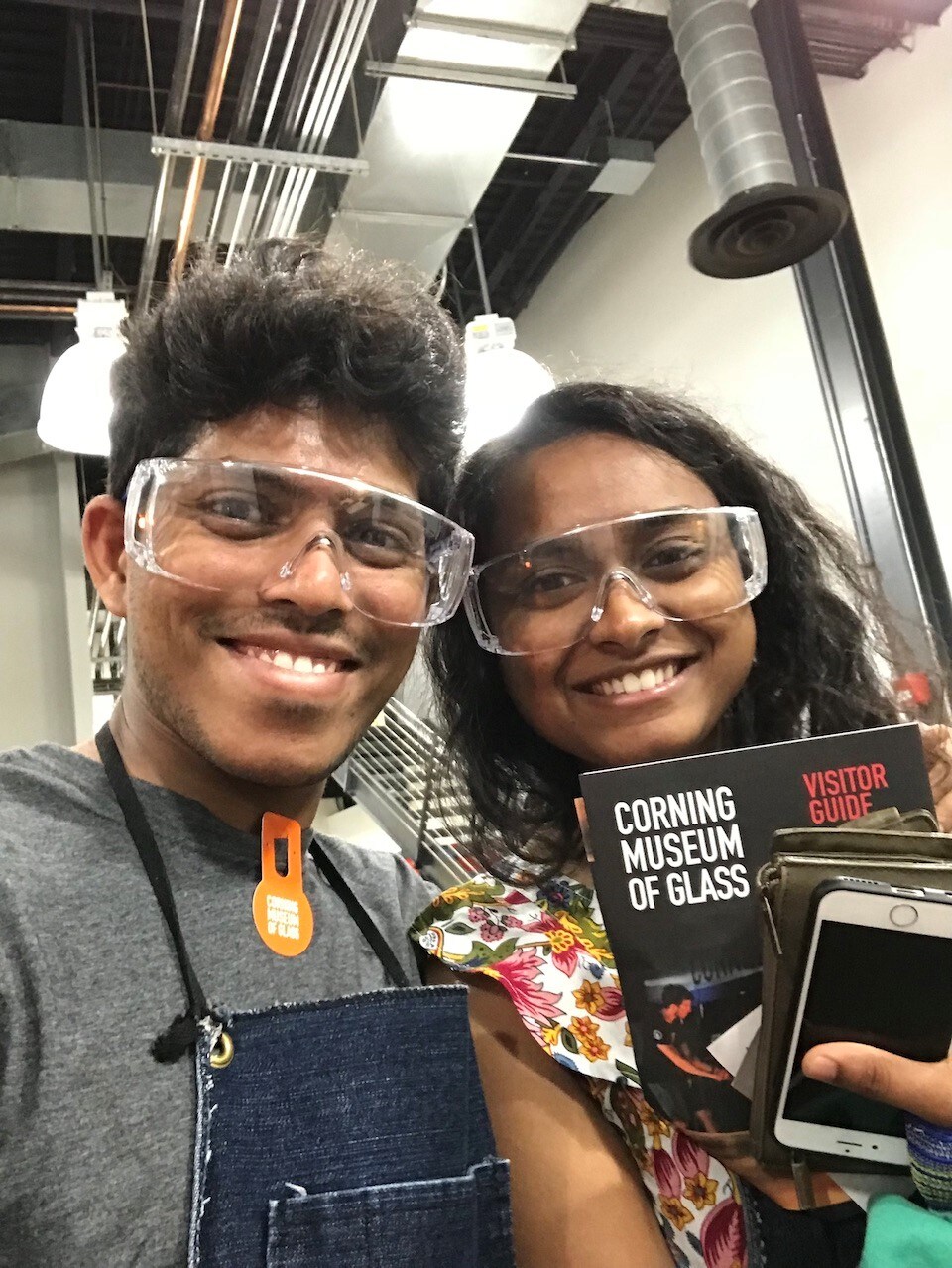He makes hundreds of pink origami lotuses bloom in the Rubin Museum of Art with a twist of his fingers.
He recreates a surreal miniature world of animated figures and glittering jewels in the show windows of Cartiers on Fifth Avenue.
And yet, Uttam Grandhi is a mechanical engineer who’s created new PPE and masks for this age of COVID. He has won recognition from MIT, Harvard University, and NASA for his inventions in augmented reality, and origami.
Grandhi proves that you can master both left and right brain thinking and also succeed in the gig economy where 9 to 5 jobs are fast disappearing. It is possible to be your own man and do projects which intrigue you.
When he was growing up, his father worked in the naval yard and his mother was with a telecommunications office in Visakhapatnam. He says, “My mom was really creative when she was young and used to do caricatures. She’s my inspiration and has always been my support.” He recalls he was punished by the school principal for participating in a rangoli competition but his mother was totally encouraging, telling him he could do anything he wanted to do. He says: “I never felt bad because in my house they never discriminated tasks based on gender.”
As a student in the fourth grade, he used to write his friends’ names on grains of rice and also carve sculptures out of pieces of chalk. Art was always a way of life even while he studied engineering.
Now an engineer in Brooklyn, Grandhi who is an alumni of the Birla Institute of Technology and Science, Pilani in India, pursued the Interactive Telecommunications Program (ITP) at New York University’s Tisch School of Arts. This was a game-changer for him.
The ITP program really opened up a new world for the 26-year-old who had grown up in an environment where science and art are totally different disciplines. “I’m an engineer but life is much more than that. I realized that when I came to this program, with peers from so many different countries,” he says.
In this open-ended program, engineers can explore art, and artists can delve into science and technology with tools like augmented reality, virtual reality, 3 D printing and biology electronics. He says: “All these tools were given to us and we were asked to make something that we are really inspired about. It is not about technology but it’s all about the story that you want to tell.”
For the past seven years, Grandhi has been exploring this mixed universe, responding to new ideas and materials to invent new concepts. His is not a 9 to 5 desk job and he relishes the gig economy with diverse, innovative projects; fortunately, he finds that the projects which pay the bills are also challenging and creative. He recently wrapped up a project with NYU School of Dentistry where he created virtual reality modules to train 800 future dentists to perform certain anesthetic procedures.

Uttam Grandhi at the PlayGAMI in San Mateo
Art and engineering merge in his projects to create a new reality. Grandhi says, “I do origami in augmented reality so my interest in art is still the same, but the medium changes, and that’s what motivates me to think of all these interdisciplinary projects and ideas. I would say most of my projects try to bridge the gap between the digital and physical realms.”
As he points out, “I balance my time between screen time and making an actual art form with my hands. So I do idols for the Ganesha festival, and I like to create lamps for Diwali - just to always keep making something and not always be in front of the screen.”
Grandhi recently founded Open PPE Project in collaboration with researchers from MIT in response to the COVID-19 pandemic, inventing an origami-based, low-cost, N95+ filtration face mask that can easily be replicated anywhere in the world without the need for advanced machinery or skills.
“We designed an open-sourced, low-cost PPE kit for communities across the world (A HEPA filter based face mask with N95 level filtration, Soda Bottle face shield and a raincoat body suit),” says Grandhi. “We are currently looking for pro-bono social media managers, and fundraising experts to help us get 100,000 PPE kits to India.”
His artworks have been exhibited at Cartier, MIT, Tokyo University, NYU, Rubin Museum, National Museum of Mathematics, Gulliver’s Gate Miniature Museum, SIGGRAPH, and Nagoya University. Somewhat of an inventor, Grandhi often creates games and augmented reality projects which are one-of-a-kind and don’t exist anywhere else.
“I tend to keep two gigs running, one that keeps me busy during the day and the other at night. More often than not, these two gigs are no way related to each other but I strongly believe both influence each other on a subconscious level,” says Grandhi. “I take up jobs across design, fabrication, programming, electronics and arts to retain the elasticity of my mind.”
A big asset to Grandhi is his wife Rakshitha Shamakumar who is also a structural engineer and whom he met on a traditional matrimonial website. Both are from India and met in the US where both were studying. “She’s a problem solver basically,” says Grandhi.

Uttam Grandhi with Rakshitha
“She comes from an engineering background too and sometimes when I’m stuck. I reach out to her and she gives me all these beautiful solutions to problems!”
Recently Grandhi was involved with the Lotus Effect exhibition at the Rubin Museum in New York where people were invited to each fold an origami lotus instructed by him. All these lotuses will become part of physical installation, a symbol of gratitude for all those who helped during New York’s dark times.
As the Rubin Museum noted, “Lotuses grow in muddy, murky waters, rise to the surface, and unfold. They bloom untainted by the muck and serve as a reminder, albeit a temporary one, that moments of beauty can emerge from the toughest conditions.”
Under Grandhi’s tutelage, people have been creating their own pink lotuses and some have been sent in from different parts of the world. Soon the museum will be displaying these scores of blooming lotuses as a sign of human resilience.
Ask Uttam Grandhi what gives him the most joy in life, and he says, “Being able to have a positive impact on someone’s life - that has been my pursuit in whatever I do. I was lucky enough to have been given the opportunity to train future dentists, 800 of them in the spring semester. So that has been a huge meaningful thing for me.”
Lotuses at the Rubin Museum, dental students at NYU and animated figures in the windows of Cartiers – Uttam Grandhi certainly inhabits many worlds.
Lavina Melwani is a New York-based journalist who blogs at Lassi with Lavina. Read her columns here.